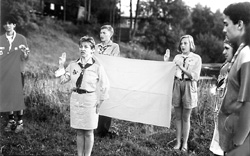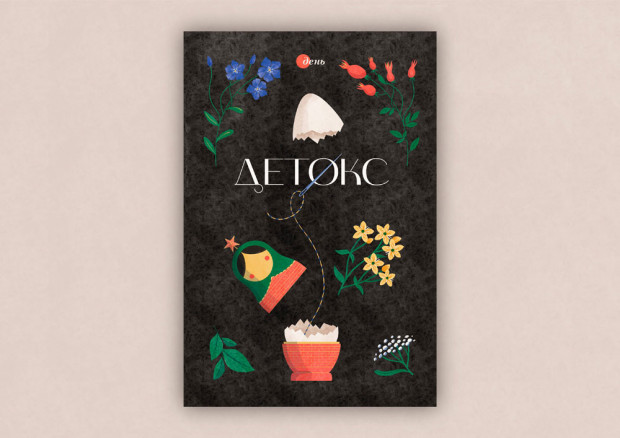PLASTUNY: Ukrainian Scouts

Today’s Plast (Ukrainian Scouts) does not seem make as strong a public impact as expected by those reviving the movement here at the end of the 1980s on the wave of Ukraine’s national cultural revival.
Over a decade of its legal existence the movement has failed to become truly mass movement. However, considering the abyss between the euphoria ten years back and the way we live, and the fact that Plast is still alive and well, this could be described as an attainment.
There are over 8,000 Plast members — or plastuny — operating in all regions in Ukraine. Plast is the largest and most clearly structured volunteer organization of all that have emerged of late and consider themselves related to Plast, aspiring to represent it in the Boy Scouts World Conference.
In fact, such representation claims — particularly by the Skauty Ukrayiny (Scouts of Ukraine) — are the main obstacle in Plast’s being admitted to the Boy Scouts World Conference, for the universally adopted procedures say a country can be represented by only one national organization.
The Ukrainian public, primarily absorbed in the mounting struggle to survive, is indifferent to these nuances. Many of those that know something about Plast turn out to have vague, often distorted concepts, associating the plastuny with the Young Pioneers of the Soviet Union, albeit nationalist- minded now.
In reality, the Bolsheviks borrowed something from the Boy Scouts when organizing their Young Pioneers. While there are certain distinctions between Plast and the Young Pioneers in terms of training, the ideologies are polarized. With Plast, the underlying educational idea is to serve God and country. With the Young Pioneers, it was being ever prepared to fight for the cause of Communism.
From the outset, scouting was a “big game” started by British officer Robert Baden-Powell at the turn of the twentieth century, which quickly became an obsession for British youth, His Scouting for Boys is still considered the scouting handbook. From the UK the scouting movement spread to Europe and overseas.
In Ukraine, then divided between Russia and Austria-Hungary, the movement made its first tentative steps in 1911, in Halychyna, largely due to Petro Franko (son of the Ukrainian writer Ivan Franko) and Ivan Chmola. In 1912, Oleksandr Tysovsky, a physician, founded the first Boy Scout teams and called them kureni (squads) of the plastuny (plural of plastun, Cossack scout). Similar organizations in other countries also used national coloration (like the charcerzi in Poland and Paterinder in Germany).
Before World War I, less successful attempts to set up Boy Scouts organizations were made in Kyiv and Odesa.
Between the wars, Plast could first develop only in Western Ukraine (under Poland since 1920), but in 1930 it was banned by the Polish government and went underground. Summer Plast camps were set up under different names, trips and meetings organized and magazines published, yet the Plast ranks had noticeably dwindled as fewer enthusiasts were willing to join the organization.
Naturally, after World War II, Plast as such was out of the question in Soviet Ukraine. Instead, the movement spread among ethnic Ukrainian communities in the United States, Canada, Austria, and other countries, quickly blending with local scouting.
In the late 1980s, Plast was revived in Ukraine with help and influence from the Diaspora, yet that influence should not be overestimated. Primarily it came from an outburst of patriotic enthusiasm and dedicated effort on the part of local Ukrainians, yesterday’s Young Pioneers and Komsomol members who knew about Plast from their parents and grandparents.
Reviving Plast in post-totalitarian society was not easy, yet a traditional structure based on scouting ideas was reproduced over a comparatively short period.
Thus, every Plast organization is divided into 4 uklady (groups/teams/sections). The youngest uklad consists of children aged 6-11, with boys and girls included in separate teams/sections. A hnizdo (nest) is made up of 2-4 royi (plural of ryi, swarm as of bees).
On reaching 12 years of age, a “novice” is transferred to a junior uklad. Here, instead of ryi and hnizdo, they are organized into hurtky (hurtok is a small circle or group) and kureni (kurin’, a company of Zaporozhzhian Cossacks).
At the age of 18, Plast members are considered to have completed their training and can join senior uklady. Over the age of 25 they can become senior plastuny. In most Plast organizations all four uklady are present, forming a Plast station.
One of Ukraine’s first Plast stations appeared in Ternopil in the late 1980s. According to Hryhory Burbeza, senior plastun and deputy to the city council, the local plastuny organized their first summer camp on the eve the August 1991 coup in Moscow.
Over the years the local organization has evolved and held camporees without any assistance from the state, except a spacious two-story building in the downtown section made available several years ago when Vyacheslav Nehoda became mayor of Ternopil.
Serhiy Yuzyk, head of the regional Plast organization, says some 400 plastuny are now active in Ternopil oblast. Not much numerically but the only active regional children’s and youth organization.
Ternopil Plast leadership believes that their marginal status, compared to world scouting, is explained by the state’s indifference on the one hand and the stand taken by those in charge of the Eurasian scouting sector on the other. For some reason the Boy Scouts World Bureau in Geneva considers Ukraine part of it, while Plast counterparts in the Baltic states are earmarked “European.” Eurasian sector coordinators in Moscow seem to favor the numerically smaller Skauty Ukrayiny and take a dim view of Plast.
Let us hope that the Plast Scouts of Ukraine, dating back over eighty years and having good and diverse traditions, will overcome all their hardships to worthily represent this country in world scouting.
№10 March 28 2000 «The
Day»
In using our publications, reference to The Day is
mandatory. © "День"






